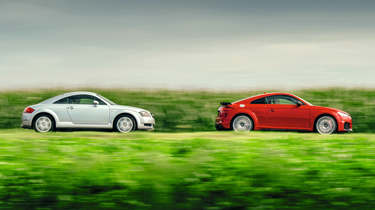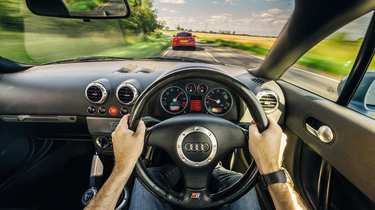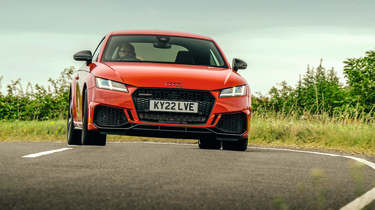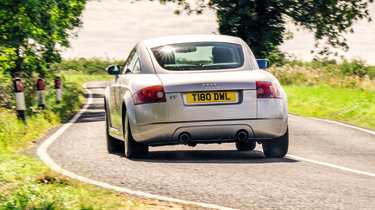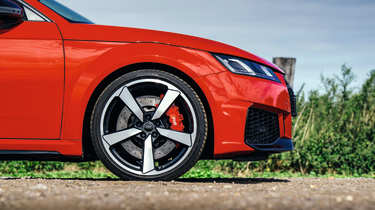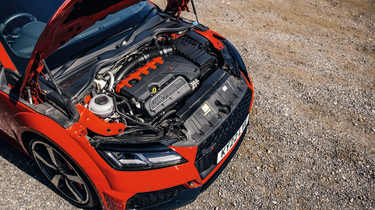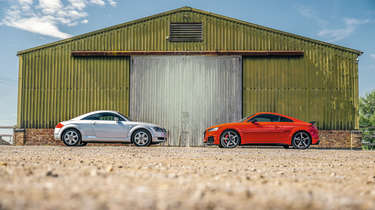Audi TT Mk1 v Mk3 RS: driving Ingolstadt's first and final design icon
As a star of the very first issue of evo, Audi’s design icon is a car entwined with this magazine’s history. But now it’s no more. We drive an early Mk1 quattro alongside a late Mk3 RS to find out if it enters retirement with grace
Should we consider the Audi TT more of an icon? Revisit some of our ‘greatest ever…’ lists and there’s not an example to be found, not even amongst evo 135’s exhaustive ‘100 Greatest Driver’s Cars’. Flick forward a dozen pages in that 2009 issue and you’ll find the freshly launched Mk2 TT RS declared ‘a good Audi, but not a great driver’s car’, hammering the point home somewhat.
Yet the curvaceous Mk1 TT played a significant part in this magazine’s history. No, I’m not talking about the occasionally baffling Project Veyrog, but rather the early example that was one of the stars of issue 001 in 1998. It was a key road test of what would prove to be a pivotal car in the regeneration of Audi’s brand image; so key that we deemed it vital to pop an H-plate Audi Quattro 20V on expenses to drive down to its newer relation’s Umbrian press launch.
> The 2025 Audi RS3 gets a host of improvements – and smells nicer too
Their modest age gap now seems implausible in photographs – how on earth did one company produce both cars within the same decade? ‘The TT was inspired by Bauhaus,’ says former head of Audi Design Marc Lichte. ‘Its universal design philosophy of “less is more” – the omission of everything unnecessary and insignificant – was so radical and so courageous that the TT quickly achieved the highest attribute of good design: to be timeless.’
More reviews
Dickie Meaden was a little more succinct back in issue one, declaring the TT’s curves ‘bold and breathtaking’. As I climb inside the example we’ll be driving today and shut the door with a satisfying, late-’90s Teutonic THWUNK, I feel just as effusive. A quarter of a century on, this pure and simple genesis of TT – sans the infamous spoiler – really does feel timeless.
This 1999 example is particularly clean, even if it’s wearing a princely 131,000 miles. You had a choice of two 1.8-litre turbo fours at launch, each boasting 20 valves: the 178bhp tune used a five-speed manual gearbox, while the headline 222bhp version cost a few grand more and gained an extra forward gear. Naturally that’s what we’ve sourced here. Badged ‘quattro’, both debuted a new Haldex four-wheel-drive system alongside the Mk4 Volkswagen Golf 4Motion. Indeed, ‘a Golf in a frock’ was one of the more disparaging remarks thrown at a car that was perhaps the most overt demonstration of platform sharing yet. The TT possessed a 90mm shorter wheelbase than its contemporary Audi A3 sibling while gaining wider tracks, overhauled suspension and a bespoke steering rack and brakes.
While the design-led ethos of the Audi TT never changed, its mechanical make-up traversed all manner of terrain in the decades that followed. Front- and four-wheel drive, manual and twin-clutch, four, five and six cylinders, petrol and diesel. But there was only one option for the other car to bookend this test: the most powerful TT RS.
Regular readers won’t need too much of an introduction, the RS you see here having retired from the evo Fast Fleet at the end of last year. It pairs the 2.5-litre turbo five that’s won countless ‘International Engine of the Year’ awards with the latest, fifth-generation Haldex 4WD and a seven-speed S-tronic twin-clutch transmission, its peak output a whisker short of 400bhp. Nearly twice the power with nary another kilo means almost half the Mk1’s 0-62mph time too, and I’d not bet against its claimed 3.7sec being proved a little pessimistic were you to rig up some timing gear and activate launch control. The RS rides 10mm lower than a standard TT, while its Drive Select system not only alters the tautness of its magnetic damping, but the torque split between its axles – though 50:50 is as dynamic as it gets.
Not only are we marking the 25th anniversary of this magazine with this test, but also the end of TT production altogether. We wouldn’t want a bunch of deft two-doors clogging up production resources for all those electric crossovers now, would we? Being less facetious, it’s simply a sign of the times and I can’t imagine Audi took the decision to euthanise its design beacon lightly. Flick through other chapters of the evo back catalogue and you’ll find a TT fighting off five competitors in a vast coupe group test. A fantastical comparison today if you’re unwilling to stretch the definition of ‘coupe’ with the same flamboyance as most carmakers’ marketing departments.
Back in 1998, Dickie lauded the TT as the first Audi with genuine steering feel in over a decade, and celebrated its supple ride too. Yep, the world of fast Audis has certainly mutated since. ‘There’s no doubting the TT is a fabulous car,’ he concluded, though it couldn’t quite escape its mundane underpinnings, instead fully maximising the potential of them.
A subsequent group test in a sopping-wet Wales had Dickie calling out unpredictable on-limit handling, albeit ‘nothing a good stability control system wouldn’t cure’. Ever the Mystic Meg. Speculation about the dangers of the TT’s on-limit high-speed handling began in spring 1999, shortly before UK deliveries of the car kicked off. A handful of deaths were ultimately attributed to the car’s high-speed handling, all occurring north of 110mph in the unique environment of derestricted autobahn.
A reported £170m update brought heavier steering and stiffer suspension as well as the subsequent addition of stability control. Audi AG announced a recall in October ’99 and a month later Audi UK offered the chassis mods and a dinky rear spoiler on its cars, with ESP retrofitted a few months later, usefully filling a blank button that’d otherwise sit incongruously on an exquisitely crafted dashboard. The tweaks were understandably rushed in but were apparently already planned for the TT’s mid-life update, such is the cadence of big OEM engineering teams. The below-the-skin changes were the most crucial and thus some cars – including this example now owned by Audi UK – ducked out of the ducktail in favour of a shape more faithful to the svelte 1995 TT concept.
A comparison between pre- and post-recall TTs in evo 019 saw John Barker proclaim the modified TT a more planted and predictable road car. Indeed, the occasionally boisterous agility that Dickie found on those earlier drives appears to be absent today, but traded for a noble cause.
What a striking place to sit, though. From its lovingly crafted aluminium grab handles to its pair of heated seat buttons that pop out satisfyingly and flick through six(!) levels, the detailing is exquisite. Still, the large diameter, thin rim and wholly circular shape of its steering wheel timestamp the cabin long before you’ve gently pushed open the embossed aluminium cover on its dashboard to reveal a hidden cassette deck. The air con utilises proper physical controls but the breeze coming from the vents is akin to that of a small portable pocket fan. With flattening batteries. Yet it feels a fresh and modern place to be despite its paucity of glaring touchscreens.
The ride really is supple – sometimes too aloof in its reactions over more testing roads – while the steering rack has notable heft and is allied to a gearshift that is tight, short and physical. These are deeply unusual sensations in a fast Audi now. Its weight figure (1465kg) is close enough to the newer car’s to ensure its acceleration feels quick, just not shockingly so. The engine exhibits more character than I dared hope, a deep bassline accompanied by cute turbo chuffs and whistles right from the off, particularly with the windows rolled down – via indulgently bespoke switches – to appease the asthmatic vents. It demands to be revved as soon as it’s up to temperature, pulling strongly for its considerable mileage, while the manual’s precise gate allows you to confidently brush the red line every time, knowing you won’t fumble the upshift.
This engine wasn’t showered with praise in period, but perhaps the ubiquity of 2-litre Volkswagen Group four-cylinders since applies a charming sepia filter to this smaller, harder-working unit. Or maybe the increasing novelty of rowing a car like this along with my own gearchanges simply sparks it more obviously into life. What’s harder to unshackle is the chassis beneath, which never places ‘involvement’ high on its agenda. Perhaps understandably given the backstory.
As I switch to the newer car, staff writer Yousuf Ashraf takes a turn in the Mk1. ‘It’s quite unnerving when you approach the limit,’ he’ll report later, ‘like you’re a step behind the car and removed from the action. It’s really soft so you can bully it into moving around a bit, but it never feels natural doing so. There’s a numb, nose-led feel and you quickly find the limits of the dampers on a bumpy road. I didn’t expect the same tight control as the TT RS, but I had hoped the Mk1 would feel more like a sports car.’
The TT RS certainly feels like a different animal. I’ve skipped the foreplay of trundling through town and along A-roads and I’m having a ball. The steering has shed all the original’s weight yet feels quicker and more precise, and despite a poor flow of communication through its flat-bottomed wheel, the front axle snaps keenly into turns and I feel immediately more comfortable leaning right against its grip limits than I did in the Mk1, quickly loosening its stability systems to dig even deeper into its talents.
‘The RS feels ordinary at town speeds and needlessly stiff, but there’s a huge character change when you up the pace,’ Yousuf astutely notes. ‘The chassis is keyed in and gives you massive confidence, and the motor sounds epic above 4000rpm. It’s still fundamentally a point-and-shoot car, but there’s enough drama and communication to keep you engaged.’
Point and shoot it may be, but it demands less aggression from its driver to start loosening its hips than I feared. Coax a small slide out of the Mk1 and it feels like frivolous fun, but here the car doesn’t seem to lose its momentum and corrective lock feels optional as the RS bounds forwards with a modest yaw angle. Just imagine if they’d engineered a more rear-biased torque split…
Its suspension is a tightly knurled fist in urban environs, but relaxes just enough with speed. It has moments of being caught out and will thump right into rougher surface compressions with little decorum, but its level of control embarrasses the older car and breeds confidence in its driver – quickly. Swapping the optional 20-inch wheels of this ‘Vorsprung’ spec car for the standard 19s might do wonders for its everyday amenability, but then you’d probably undermine its OTT aesthetic, which I’ve no doubt drew many TT RS buyers into the showroom. Beside its neatly tailored ancestor it appears to be wearing shoulder pads, while it’s a relief to discover there’s at least some aerodynamic work being done by the large fixed spoiler and its improbable winglets, which are ever present in the side mirrors as you drive.
I’ve not even mentioned the engine, which truly credits how much the rest of the car has impressed me. Such is the proliferation of four-cylinder motors that you’d be forgiven completely for buying a TT RS purely for its exotic heart. Audi didn’t rest on its numerous laurels, either. The Mk3 TT RS arrived with a whole 26kg skimmed from its predecessor’s engine bay, 18kg by a new aluminium crankcase alone, while a 1-2-4-5-3 firing order produces the offbeat, vintage rally-stage pastiche you rightly crave from a unit like this. Ongoing regulations have dimmed its volume over time, but it still sounds unlike anything else in its class. Goes like it, too, especially with S-tronic feeling this sharp. This is a sensationally quick car and whatever the stretch of road, it’s hard to imagine its more serious R8 sibling feeling any more forceful. This is true junior supercar performance.
Reports are mixed inside. The quality and detailing still slap a smug grin on your face, while its ‘Virtual Cockpit’ digital dials – pioneered by the Mk3 TT – look fantastic but aren’t the most intuitive to use with the steering-wheel switches. Having a central touchscreen would look worse but function better, not least because it would allow the passenger to have some level of input on longer journeys. Ever the designers’ baby, the TT. The bells ’n’ whistles nature of the range-topping RS means carbon has overtaken aluminium as the interior trimming of choice, too. I doubt ‘timeless’ is the right descriptor here.
Buy the older car and you’ll have to covet its design credentials at least as much as its dynamic abilities, though prices still sit below £5000 for relatively smart examples, bringing it easily into most budgets. The newer car drives with greater focus but boy, does its styling betray that. Early Mk3 RSs command £30k, with the Mk2 – the first generation of TT to get an RS, with 335bhp – available for half that.
‘The coupe world will be a poorer place without it,’ remarked managing editor Ian Eveleigh as he bid farewell to this Tango Red TT a few months ago, and he’s bang on. Safety-first handling (eventually) yet tagged with two of the most dangerous letters in motorsport, something about the TT has always just worked, even if it’s never quite elbowed BMWs, Porsches or Alpines from the top of group-test podiums in the years following its dramatic origin story. Perhaps it hasn’t truly carved itself a place in the evo hall of fame, yet it’s been with us since day one. For a quarter of a century its deft design has been printed on the pages of this magazine. But now we must part ways.
| Audi TT quattro (1999-2005) | Audi TT RS (2016-2024) | |
| Engine | In-line 4-cyl, 1781cc, turbocharged | In-line 5-cyl, 2490cc, turbocharged |
| Power | 225bhp @ 5900rpm | 394bhp @ 5850-7000rpm |
| Torque | 206lb ft @ 2200-5500rpm | 354lb ft @ 2250-5850rpm |
| Weight | 1465kg | 1450kg |
| Power-to-weight | 156bhp/ton | 276bhp/ton |
| Tyres as tested | Pirelli Cinturato P7 | Pirelli P Zero |
| 0-62mph | 6.6sec | 3.7sec |
| Top speed | 150mph | 155mph |
| Price new | £29,650 | £59,450 |
| Value today | £2000+ | £30,000+ |
This story was first featured in evo issue 323.
